AI-Driven Predictive Maintenance with H2O AI Cloud


According to a study conducted by Wall Street Journal , unplanned downtime costs industrial manufacturers an estimated $50 billion annually. Forty-two percent of this unplanned downtime can be attributed to equipment failure alone. These downtimes can cause unnecessary delays and, as a result, affect the business. A better and superior alternative is using the machine’s historical data to plan and manage in advance the maintenance requirements, thereby taking care of both planned and unplanned downtimes. This process is called predictive maintenance, and today, one of the major enablers of Predictive Maintenance is Artificial Intelligence-enabled Automation.
In this article, you will learn how H2O.ai’s solutions enable manufacturing enterprises to roll out their Predictive Maintenance strategies using machine learning successfully. This increases the efficiency of existing processes and productivity while decreasing costs.
This article is based on a webinar titled — AI-Driven Predictive Maintenance of Industrial Equipment. Here is the link to watch the recording. The session was presented by Asghar Ghorbani, Lead Data Scientist at H2O.ai.
Current Maintenance Approaches in Industry
As per a study conducted by Deloitte, predominantly there are four basic maintenance approaches used in industries as per a study from Deloitte :
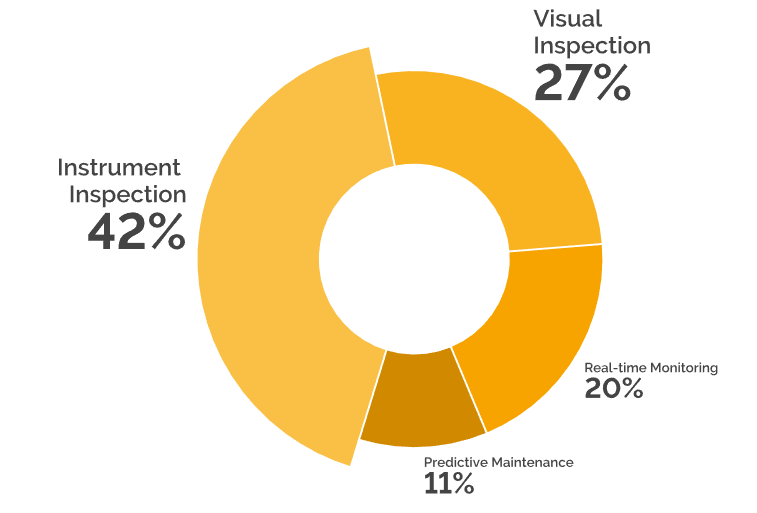
- Level 1: Visual inspection — refers to the manual and scheduled maintenance strategies. More than 25 percent of current maintenance practices fall in this category.
- Level 2: Instrument Inspection: This type of inspection is supported by tools and assisted by instruments. However, it is still a manual process. More than 40 percent of industries are on this maintenance level.
- Level 3: Real-Time Monitoring refers to monitoring the equipment in the field in real-time. Although an improvement over levels one and two, still most of these systems are rule and condition-based.
- Level 4: Predictive Maintenance: The ideal goal for industries is to move to level four, termed predictive maintenance. Overall equipment effectiveness of more than 90 percent can be achieved by making predictive maintenance a part of the industrial pipeline. Unfortunately, only about 11 percent of the industry currently uses predictive maintenance systems.
What is Predictive Maintenance?
The Fourth Industrial Revolution refers to the next iteration of traditional manufacturing and industrial practices. Predictive Maintenance aim at minimizing maintenance costs by the assessment, prognosis, diagnosis, and health management of industrial equipment using intelligent and automated processes.

As opposed to general thought, predictive maintenance is not only limited to the manufacturing industry. It has a vital role to play in other sectors, for instance:
- In the wind power industry, it is critical to plan the maintenance schedules in a very consistent and accurate way to avoid costs.
- In Air airplane industry, predictive maintenance can improve customer satisfaction by avoiding flight delays and cancellations.
- In Fleet operations management and operation, Predictive maintenance can help to meet strict SLAs.
There are other innumerable examples where an efficient maintenance strategy can go a long way in improving business and decreasing costs.
Advantages of Predictive maintenance
Predictive maintenance can have a significant effect on how industries function today. Some of the advantages of using Predictive maintenance over traditional methods are as follows:

The industries have grappled with the above challenges for a long. However, the situation will get even more complicated in the coming years. It is estimated that there will be explosive growth of IoT devices in the next couple of years. By 2027 that will be about 40 billion IoT devices, and that will need to be managed effectively; the primary use case that will drive IoT adoption is predictive maintenance.
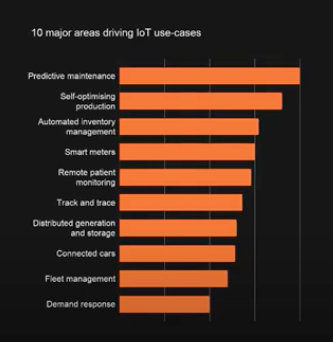
Approaching Predictive Maintenance
Predictive maintenance is essentially being able to answer the following four questions concerning your equipment.

To answer the above questions, we need data — sensor data, vibration data, sound or image data, etc. Once this data is collected, it is processed to predict or estimate the remaining useful life of the components. This is vital because you probably want to trigger maintenance to avoid the breakdown of your equipment. The most effective way to do the maintenance is not only before the failure event but even before the lead time that the maintenance requires. This point is denoted by the Prediction Point in the diagram below. This approach not only avoids equipment breakdown but also saves from unnecessary maintenance.
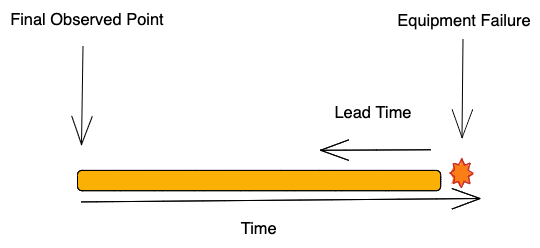
Getting data is one thing, and extracting valuable insights from it is another, and this brings challenges of its own. Broadly speaking, the challenges associated with predictive maintenance can be summed up as follows:
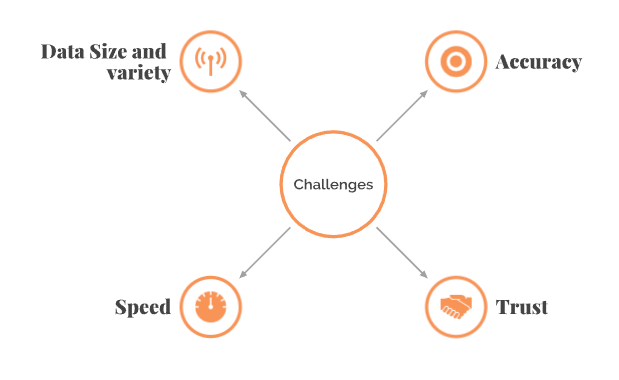
- Data Size & Variety — The massive amount of data can pose a problem.
- Accuracy — How accurately can we answer the four questions regarding the equipment, i.e., will it fail, what will fail, when, and why will it fail?
- Trust — Even after we have the answers, can we trust the predictions?
- Speed- Time is of the essence here. How fast can we make predictions? Predictions that are made after the equipment has failed are of no value.
How can Artificial Intelligence(AI) help?
The use of AI is quickly changing the business landscape, even in traditionally conservative areas. Machine learning algorithms are not only good at identifying the signal in the data but also identifying meaningful information from it. At the core of this approach lies automation, explainability, flexibility, and scalability. Using machine learning for predictive maintenance offers multiple advantages. The figure below shows how the machine learning algorithms can ingest huge amounts of data and identify the crucial features from it, thereby providing predictions.
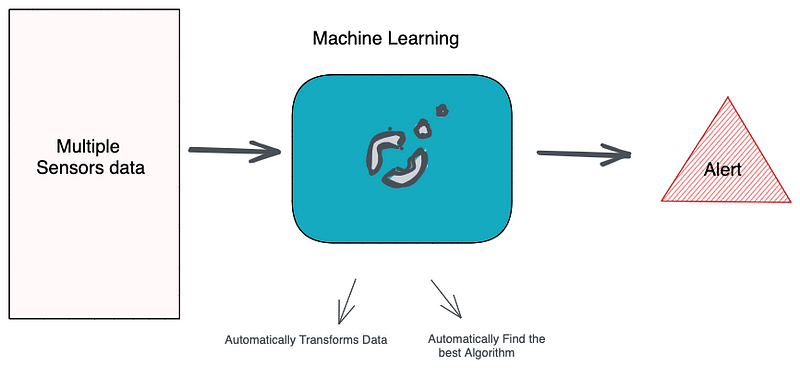
Predictive maintenance with H2O AI Cloud
H2O AI Cloud is an end-to-end platform that enables organizations to rapidly build world-class AI models and applications. H2O AI Cloud harnesses the true potential of AI by enabling every employee, customer, and citizen with sophisticated AI technology and easy-to-use AI applications. It has been developed to empower everyone in the organization to innovate and use AI to make better decisions, streamline operations, reduce risk, and personalize customer experiences.
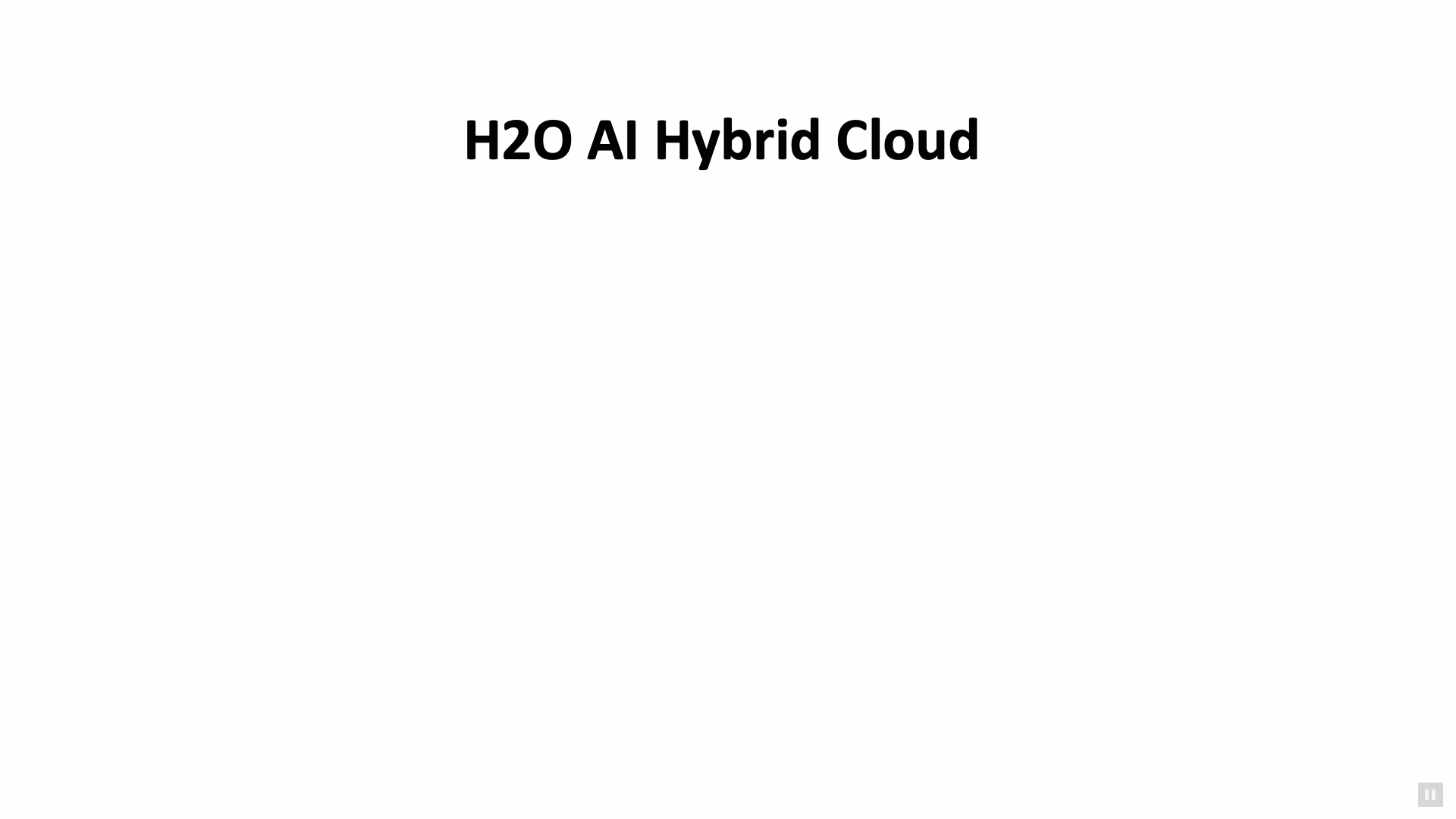
Here is a case study of Turbofan Engine Failure to showcase how the H2O AI Cloud works for a predictive maintenance problem. The data comes from NASA’s turbofan engine degradation simulation dataset (CMAPSS) . The data set includes time-series measurements of various pressures, temperatures, and rotating equipment speeds for the jet engine based on the engine degradation simulation. Four different sets were simulated under different combinations of operational conditions and fault modes.

The problem at hand is to develop a machine learning model to predict the remaining useful life (RUL) of each engine in the test dataset based on time-series data of sensor measurements typically available from aircraft gas turbine engines. Our general approach would be as follows:
Creating a world-class model
We’ll use state-of-the-art automated machine learning from Driverless AI to create a predictive model which will predict whether maintenance is required or not, i.e., whether the stage of the equipment is OK, warning or failure. Here is a glimpse of the dataset in a Driverless AI instance containing the sensor readings and the stage column, which is the target that needs to be predicted.
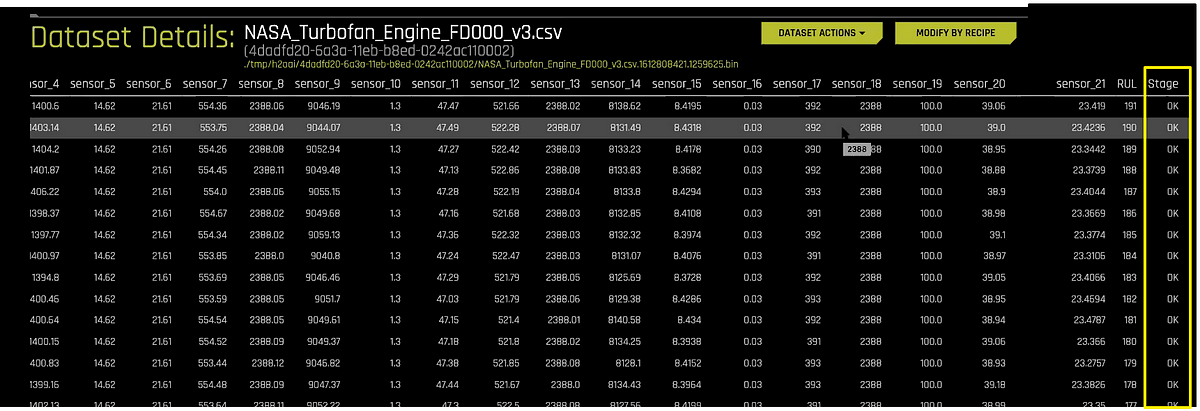
Driverless AI automatically selects the best algorithm, tunes the model, and provides data scientists and developers with a model leaderboard to continually challenge and test the champion models.
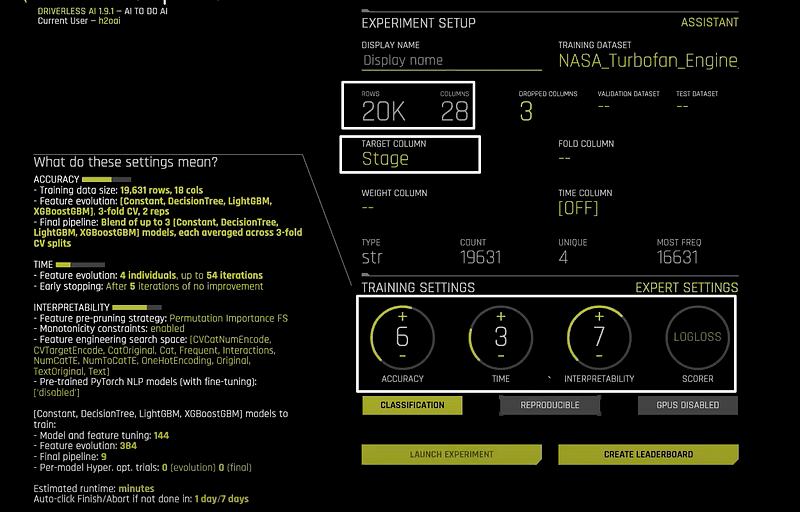
At the end of the entire experiment, Driverless AI scored 5099 features, out of which 301 were selected.

The Variable Importance tab gives a summary of the top 20 feature engineered variables. The complete list of features used in the final model is available in the Experiment Summary artifacts . The Experiment Summary also provides a list of the original features and their estimated feature importance.
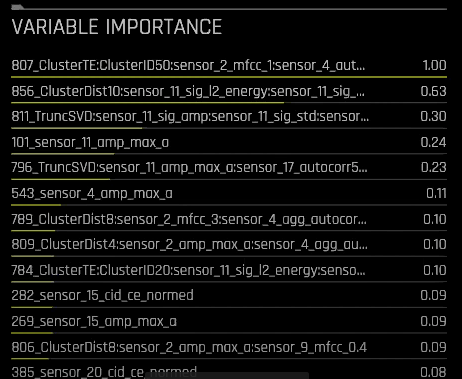
At the end of the experiment, a summary of the project will appear in the right lower corner. Out of other vital artifacts, it also displays a confusion matrix displaying the performance of the model.

Explainability
As shown in the demo above, Driverless AI saves our data scientists a lot of time which can then be used for other tasks like explaining the model predictions to stakeholders. Explainability is a vital component of AI, and it equips the data scientists to understand how the model makes decisions under the hood, allowing them to better trust the results. For instance, the Naive Shapley values on original features can show the contribution of each original feature towards the overall predictions. For example, the following graph shows that to predict alarm the model believes that the values of sensor 4 are the most important, and so on.
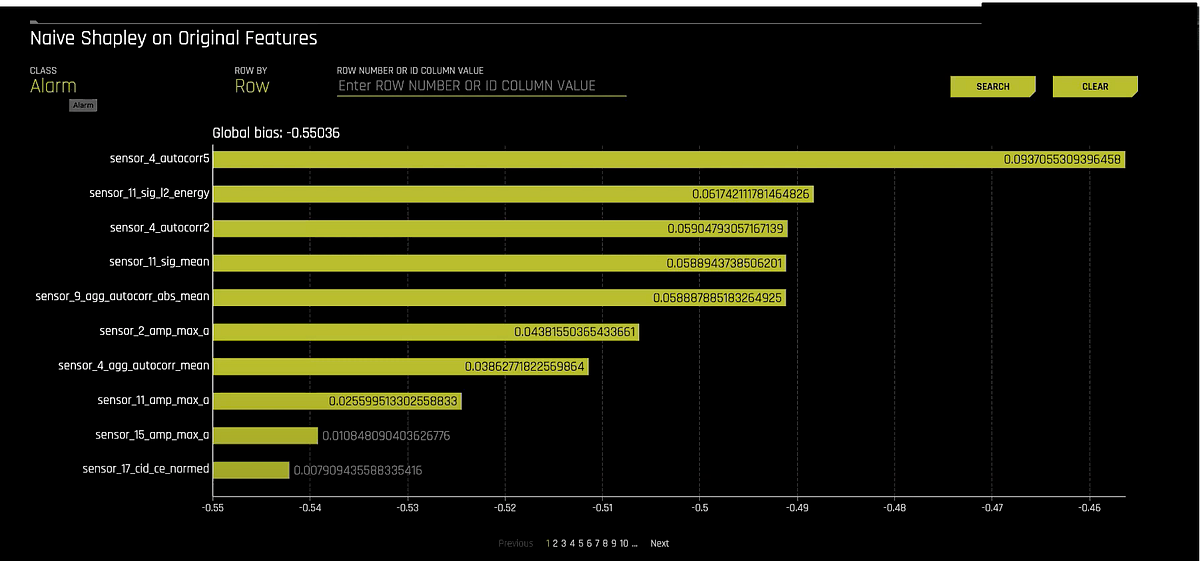
Creating Monitoring dashboard using H2O Wave
H2O Wave is a component of the H2O AI Cloud that makes it fast and easy for data scientists, machine learning engineers, and software developers to develop real-time interactive AI apps with sophisticated visualizations. H2O Wave accelerates development with a wide variety of user-interface components and charts, including dashboard templates, dialogs, themes, widgets, and many more.
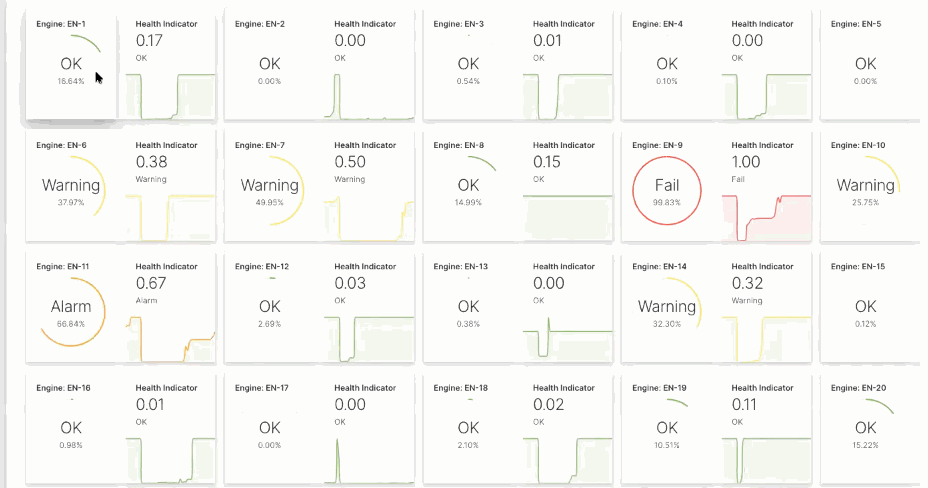
The dashboard above has been built using H2O wave based on the models built in Driverless AI. What we are observing here is the status of the equipment based on the sensors data that are streamed into this platform. This dashboard gives a real-time picture of the health of the equipment and can be easily understood by people working in the field.
Conclusion
In this article, we looked into some of the challenges companies face to implement a predictive maintenance solution and how AI and machine learning can effectively answer some of these challenges. We saw how the H2O AI Cloud enables us to create a robust and accurate model and provides us with reason codes to explain those predictions. We also saw how seamlessly these models could be converted onto an application to be consumed by different stakeholders. Having a carefully carved out strategy is imperative to the success of AI adoption in an enterprise. At H2O.ai, we’re here to help you get started and determine how H2O AI Cloud can solve your organization’s specific challenges.











